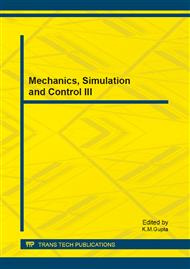[1]
Miller David S. and Carlson Harry W., A study of application of heat or force fields to the sonic boom minimization problem, NASA-TND 5582, (1969).
Google Scholar
[2]
Myrabo Like N. and Raizer YU.P., Laser induced air spikes for advanced transatmospheric vehicles, 25th AIAA plasma dynamics and lasers conference. AIAA -1994-2451, (1994).
DOI: 10.2514/6.1994-2451
Google Scholar
[3]
Levin V. A., Gromov V. G. and Afonina N. E., Numerical analysis of the effect of local energy supply on the aerodynamic drag and heat transfer of a spherically blunted body in a supersonic air flow, Journal of Applied Mechanics and Technical Physics, Vol 41, No. 5, (2000).
DOI: 10.1007/bf02468738
Google Scholar
[4]
Riggins D. W., Nelson H. F. and Johnson E., Blunt body large wave drag reduction using focused energy deposition, AIAA Journal 37, pp.460-504. (1998).
DOI: 10.2514/3.14192
Google Scholar
[5]
Kolesnichenko. YU.F. and Brovkin V.G., Microwave energy release regimes for drag reduction in supersonic flows, 40th AIAA Aerospace science meeting and exhibit. AIAA-2002-0353, (2002).
DOI: 10.2514/6.2002-353
Google Scholar
[6]
Adelgren R.G., Eliot G.S., Knight D.D., Zheltovodov A.A. and Beutner T.J., Energy deposition in supersonic flows, 39th AIAA aerospace science meeting and exhibit. AIAA-2001-0885, (2001).
DOI: 10.2514/6.2001-885
Google Scholar
[7]
Hartley C.S., Portwood T.W., Elipelli M.V., Myrabo L.N. and Nagamatsu H.T., Experimental/computational investigation of drag reduction by electric arc air spikes at Mach 10, 42nd Aerospace science meeting and exhibit. AIAA-2004-35, (2004).
DOI: 10.2514/6.2004-35
Google Scholar
[8]
Satheesh K. and Jagadeesh G., Effect of energy deposition on aerodynamic drag of a blunt body in hypersonic flow, Phys. Fluids 19. Art. 031701, (2007).
DOI: 10.1063/1.2565663
Google Scholar
[9]
Doyle D. Knight, Yuri F. Kolesnichenko, Vadim Brovkin and Dmitri Khmara, High Speed Flow Control Using Microwave Energy Deposition, 16th Australasian Fluid Mechanics Conference Crown Plaza, Gold Coast, Australia, (2007).
DOI: 10.2514/6.2008-1354
Google Scholar
[10]
John, B., Sarath, G., Kulkarni, V. and Natarajan, G. (2013) Performance comparison of flux schemes for numerical simulation of high-speed inviscid flows, Progress in Computational Fluid Dynamics, An Int. J., (in press).
DOI: 10.1504/pcfd.2014.060142
Google Scholar


